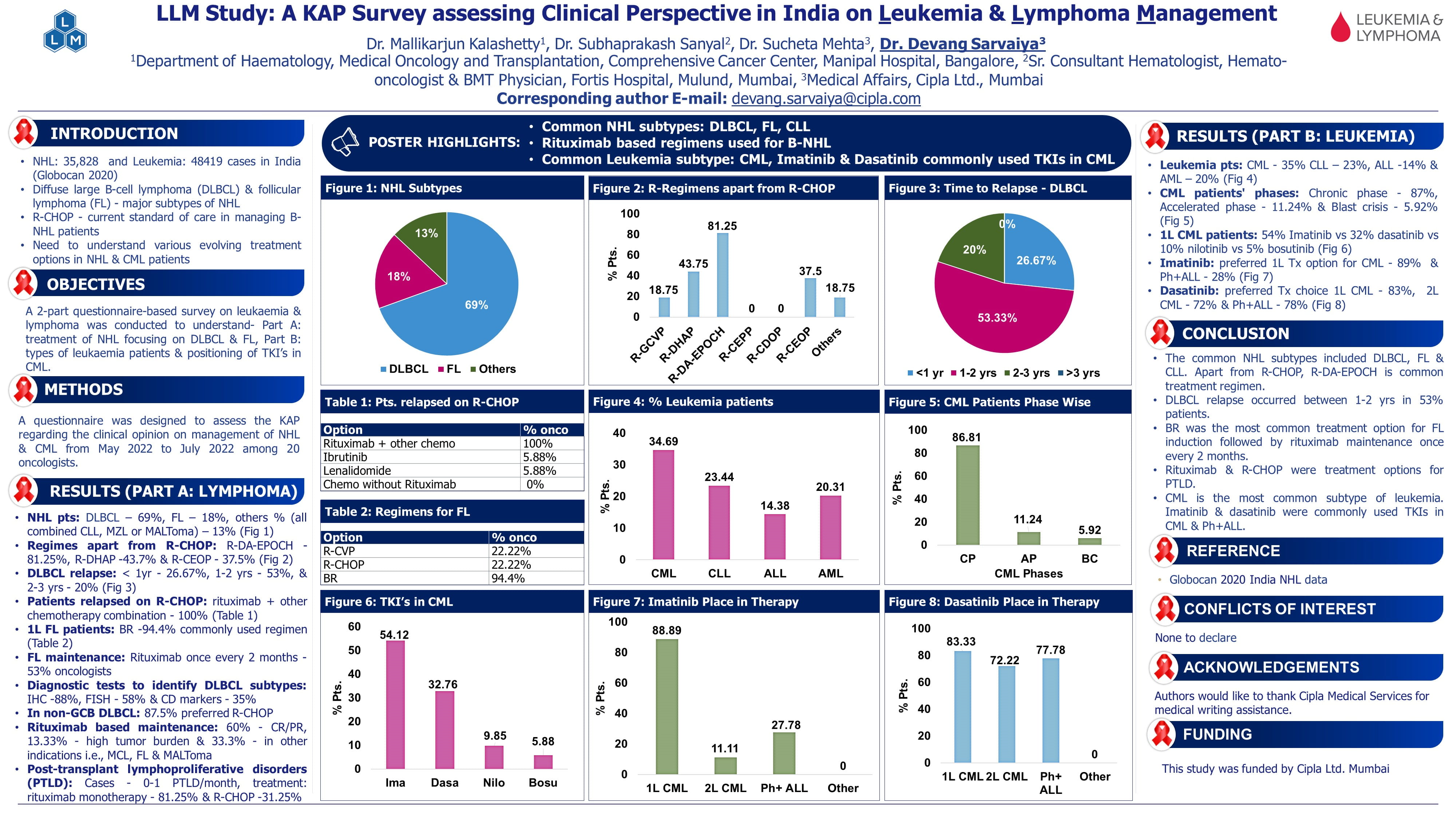Introduction: The Need for Upgrades in MDS Care
Speaker: Maria Diaz Campelo, University Hospital of Salmanca, Spain
Key Highlights
Challenges in Managing Low-Risk MDS (LR-MDS) Patients with Specific Mutations:
Managing LR-MDS patients can present challenges, particularly when patients exhibit specific genetic mutations like SF3B1.
The session addressed two case studies of patients newly diagnosed with MDS.
Case Details
-
Lower-Risk Female Patient
-
Presented with anemia and identified with SF3B1 mutation and ring sideroblasts (RS)
-
Classified as lower-risk based on morphological findings
-
High-Risk Female Patient
-
Exhibited excessive blasts and adverse somatic mutations
-
Classified as high-risk due to aggressive disease features
Key Discussion Points
-
Commonality of Lower-Risk Presentations:
-
Symptoms like fatigue and macrocytic anemia are common in MDS, with a median age of 76.
-
The inclusion of SF3B1 mutation in WHO and ICC classification systems aligns their diagnostic approach.
-
Molecular Testing and Prognostication: Use of Next-Generation Sequencing (NGS) for molecular marker panels and IPSS molecular scoring was debated as part of standard care.
-
High-Risk Patient Insights:
-
The role of specific mutations (e.g., ASXL1) was explored.
-
Dr. Garcia de Manero emphasized that rigid classification systems like ICC vs WHO might lack practical value because MDS represents a disease originating from primitive stem cells.
-
WHO Criteria & Its Role:
-
Dr. Garcia de Manero advocated for using WHO criteria for classification.
-
Highlighted that ASXL1 could act as a biomarker of sensitivity to venetoclax in high-risk MDS (HR-MDS) patients.
-
Molecular IPSS remains a fundamental scoring tool for prognosis, although the discussion pointed out that initiating therapy might not significantly alter outcomes.
Recent Developments Changing the MDS Care Landscape
In the past four years, significant advancements have reshaped the management of MDS through the approval of novel therapies and the development of new prognostic tools. Four therapies have been approved—Luspatercept for lower-risk MDS, and in the metastatic setting, oral hypomethylating agents like Decitabine combined with Cedazuridine and Ivosidenib for patients with mutant EDH1.
Additionally, two new prognostic classification systems have been introduced, adding complexity to clinical decision-making. The IPSS-M, a novel risk assessment tool incorporating molecular markers, offers improved accuracy in predicting patient prognosis. These innovations are enhancing treatment strategies and refining risk stratification in MDS care.
Can Newer Therapies Achieve the Goal of Transfusion Independence (TI) in LR-MDS?
The main goal for patients with MDS is not only to improve quality of life but also to extend overall survival, particularly by achieving TI. Transfusion dependency is linked to poorer survival rates compared to patients who maintain TI.
Recent data from novel therapies show that reaching transfusion independence significantly increases overall survival in both the short and long term. Notably, a study presented at the last EHA meeting identified that patients who achieved TI had nearly double the expected survival rate 5-yrs post-treatment. Additionally, understanding the transfusion burden is critical, as it impacts the quality of life of patients and caregivers, including work-life challenges.
Diagnostic Criteria and Differential Diagnosis of MDS
Diagnostic Criteria
-
Cytopenia(s):
-
Hemoglobin (Hb) < 12 g/dL
-
Absolute neutrophil count (ANC) and platelets below normal levels
-
MDS "Decisive" Criteria:
-
>10% dysplastic cells in at least one lineage
-
5%-19% blasts in the bone marrow
-
Abnormal karyotype typical for MDS
-
Evidence of clonality in patients, particularly in low-risk settings
Exclude Other Causes of Cytopenias and Morphologic Changes:
-
Potential causes to rule out include:
-
Vitamin B12/Folate Deficiency
-
HIV or other viral infections
-
Copper deficiency
-
Medications (e.g., methotrexate, azathioprine, recent chemotherapy)
-
Autoimmune conditions (e.g., Immune Thrombocytopenic Purpura [ITP], Felty syndrome, SLE)
-
Congenital syndromes (e.g., Fanconi anemia)
-
Other hematologic disorders (e.g., aplastic anemia)
Dr. Campelo mentioned that, the coexistence of multiple classifications for MDS, such as the WHO and ICC systems, poses significant challenges in clinical practice and research. While both systems aim to classify MDS based on genetic and morphological features, discrepancies in terminology and criteria complicate consistent diagnosis and treatment decisions. Efforts towards harmonization, like the recent international consortium's initiative, seek to unify classifications based on genetic signatures and blast percentages, aiming to streamline clinical trials, regulatory standards, and patient care. This harmonization effort is crucial to improve diagnostic accuracy and treatment outcomes in MDS.
Molecular Prognostication Enhances Risk Stratification in MDS
The integration of molecular data into the prognostic scoring system for MDS, particularly through the use of the molecular IPSS (IPSS-M), has shown to improve risk stratification. Genetic mutations such as TP53 and SF3B1 are key predictors of adverse outcomes. This molecular approach helps refine patient prognosis, with molecular IPSS proving valuable for patients with low to intermediate risk, enabling more tailored treatment strategies.
In contrast, its utility in high-risk patients is less significant due to their generally poor prognosis. Overall, molecular profiling aids in identifying patients who may benefit from specific therapies, optimizing personalized care in MDS management.
Dr. Campelo talked about VALIDATE, the largest database of MDS patients with TP53 mutations treated with HMA therapy.
-
Confirmation that TP53 mutations have a significant negative effect on survival, not on response to HMA.
-
No OS difference between monoallelic and biallelic TP53 mutations.
-
Type of HMA monotherapy used does not affect outcomes of these patients.
Rebooting LR-MDS Management: New Benchmarks and Innovative Sequential Care
Speaker: Valeria Santini, AOU Careggi, University of Florence, Italy
Key Highlights
Dr. Santini mentioned the clinical case previously discussed, focusing on transfusion-dependent MDS, highlighting unique challenges based on regional disparities.
-
Patient Overview: XYZ
-
Typical Presentation: Patient had a transfusion-dependent form of MDS, specifically RS or MDS with SF3B1 mutation.
-
Transfusion Burden: Patient experienced 6 units of red blood cells within 2 months—approximately 3 transfusions/month.
Dr. Garcia-Manero emphasized the importance of early intervention in managing MDS, especially to reduce transfusion dependency. He highlighted that starting erythropoiesis-stimulating agents (ESAs) early in patients diagnosed in the transfusion circuit setting could potentially prevent or reduce the need for frequent transfusions. If a patient is already transfusion-dependent at the time of diagnosis, active intervention should be initiated to minimize further transfusions.
A key discussion point was whether luspatercept should be used as a first-line therapy or whether ESAs should be attempted first before transitioning to luspatercept. Dr. Garcia-Manero supported that data from the COMMAND study which suggests broad use of luspatercept in both RS-positive and RS-negative patients. However, some questions remain regarding its initial use compared to starting with ESAs.
Dr. Campelo considered whether to start luspatercept or ESAs as first-line therapy and explored the possibility of combining both treatments. She noted that data supports combining therapies, though primarily outside clinical trials. Regarding the SF3B1 mutation, Dr. Campelo mentioned that it could impair prognosis, but the patient is likely still in a lower-risk setting. She recommended close monitoring, including bone marrow assessments, for changes in blast counts and clonal evolution.
Luspatercept might be a more suitable choice for this patient due to the mutation's adverse impact and the fact that ESA responses are better seen in lower-risk and lower-clonal evolution patients. However, given patient’s advanced disease stage, Luspatercept may offer better therapeutic potential, especially in transfusion-dependent individuals with a limited response to ESAs.
Luspatercept is recommended as a first-line treatment for transfusion-dependent LR-MDS patients (both RS-positive and RS-negative). It works by blocking TGF-β signaling to stimulate erythropoiesis, leading to improved transfusion independence. In clinical studies, 63% of patients treated with luspatercept achieved a 1.5 g/dL increase in Hb and maintained TI for over 12 weeks, compared to 42% with ESA therapy. The drug is administered at 1 mg/kg every 3 weeks, with dose adjustments if necessary. Approved by the FDA, luspatercept is awaiting approval in other regions. It also addresses complications associated with chronic transfusions, such as iron overload.
Dr. Santini explained the COMMAND study:
Study Objective: The COMMAND study evaluates luspatercept as a first-line treatment for transfusion-dependent, LR-MDS patients compared to erythropoiesis-stimulating agents (ESAs).
Key Findings:
-
Efficacy Comparison:
-
63% of patients treated with luspatercept achieved a 1.5 g/dL increase in Hb and TI for ≥12 weeks.
-
Compared to 42% of patients on ESAs.
-
Longer Response Duration: Luspatercept achieved a median response duration of 126 weeks, versus approximately half that with ESAs.
-
Long-Term TI:
-
Over 30% of luspatercept patients maintained TI for 1.5+ years.
-
Only 13% of ESA patients maintained similar long-term responses.
Safety Profile: The COMMAND study found that luspatercept has a favorable safety profile, with minimal safety concerns observed.
Key Safety Consideration:
-
Hypertension:
-
Severe hypertension may worsen with luspatercept treatment.
-
Blood pressure should be monitored before and during treatment.
Comparison to ESAs:
-
Adverse events with luspatercept are similar to those associated with EPO (ESA).
-
No significant risk of disease progression associated with treatment.
Dosing Guidance:
-
Starting dose: 1 mg/kg sc injection every 3 weeks.
-
Escalation: Can be increased to 1.75 mg/kg if the patient does not respond.
Dr. Santini talked about combining luspatercept with other drugs, specifically in non-RS positive MDS patients. A study by a French group, presented at an oral session, explored the combination of high-dose luspatercept and APO alpha. Although involving only a small number of patients, the study found that there was no disease progression associated with this combination. Some patients in the study were previously treated with ESA and were re-treated with this combination, highlighting an area of potential interest for further exploration.
Luspatercept in ESA Refractory Cases:
Luspatercept is an effective second-line treatment for patients failing ESA therapy, supported by data from studies like MEDALIST, showing durable TI.
Imetelstat:
-
A telomerase inhibitor approved in the U.S. for ESA-refractory, transfusion-dependent patients. Demonstrates durable responses but requires careful management of neutropenia and thrombocytopenia.
-
Efficacy: 40% TI >8 weeks, with long-term TI in 18% of patients.
-
Safety Considerations: Risks include transient neutropenia and thrombocytopenia. Dosing starts at 7.5 mg/kg IV every 4 weeks, with pre-medication required to mitigate side effects.
Embracing Change in HR MDS: Modern Solutions, New Targeted Strategies, and Emerging Opportunities
Speaker: Guillermo Garcia-Manero, The University of Texas, Houston
Key Highlights
Dr. Garcia-Manero discussed the previous HR-MDS case with the panel.
He then mentioned the IPSS-M (International Prognostic Scoring System-Molecular), which is essential for evaluating high-risk situations in MDS. Dr. Campello had previously highlighted the concept of "upstaging", where patients initially classified as lower-risk based on traditional indicators like blasts or cytogenetics may be reclassified into higher-risk categories when molecular profiles are factored in. This suggests that the IPSS-M can identify subsets of patients at higher risk, allowing for better risk stratification and more tailored therapeutic strategies. Additionally, it provides insights into potential targeted therapies, particularly for mutations like IDH1, IDH2, and others.
Clinical Trials, HMA Therapy, and Targeted Agents Are Among the Recommended Options for HR-MDS:
-
NCCN Recommendations for hematopoietic cell transplantation (HCT) Candidates (1L)
-
Allo-HCT
-
Azacitidine + Ivosidenib or Olutasidenib (for mIDH1 patients) followed by HCT
-
Clinical trial followed by HCT
-
Azacitidine or Decitabine ± Venetoclax
-
Oral Decitabine/Cedazuridine ± Venetoclax
-
High-intensity chemotherapy
-
NCCN Recommendations for Non-HCT Candidates (1L)
-
Clinical trial participation
-
Azacitidine (Category 1 recommendation)
-
Decitabine ± Venetoclax
-
Oral Decitabine/Cedazuridine + Venetoclax
-
Azacitidine + Ivosidenib or Olutasidenib (for mIDH1 patients)
Dr. Garcia-Manero mentioned the study which evaluated the combination of azacitidine and venetoclax for 105 HR-MDS patients. The dosage was 400 mg orally on day 14, of each 28-day cycle. Most patients enrolled with HR-MDS, 24% had TP53m. The combination achieved an overall response rate (ORR) of > 80%, with nearly 30% of patients reaching complete remission (CR).
Safety profile of Venetoclax + Azacitidine:
-
SAEs in 73 (68.2%) patients:
-
Febrile Neutropenia in 39 (36.4%)
-
Infections in 43 (40.2%)
-
72 (67.3%) patients experienced >1 TEAE leading to venetoclax dose interruption.
The Potential of “Total” Oral Therapy in MDS: Phase 1/2 Trial Findings: Oral Decitabine, Cedazuridine, and Venetoclax in Higher-Risk MDS or CMML
-
Study Design:
-
Population: 39 patients with higher-risk MDS or CMML
-
Intervention:
-
Oral Decitabine: 35 mg + Cedazuridine: 100 mg (days 1-5)
-
Venetoclax: Variable doses of 100-400 mg (days 1-14 on a 28-day cycle)
-
Key Results:
-
ORR: 95%
-
49% of patients proceeded to HCT
-
Adverse Events (Grade 3/4):
-
Thrombocytopenia: 85%
-
Neutropenia: 74%
-
Febrile neutropenia: 21%
-
Phase 2 Established Dose:
-
Oral Decitabine: 35 mg + Cedazuridine: 100 mg for 5 days
-
Venetoclax: 400 mg for 14 days
Three points to consider for Venetoclax dosing in MDS
-
Dosing in MDS is NOT same as in AML.
-
TLS prophylaxis is not critical.
-
Consider dose adjustments when combined with azoles, based on AML guidelines.
Ivosidenib for IDH1m MDS: Phase 1 Study
A Phase 1 study evaluating ivosidenib in 19 patients with relapsed/refractory IDH1-mutated MDS showed promising results. ORR was 83.3%, with a complete response rate of 38.9%. While the median duration of response was not reached, the median overall survival was approximately 36 months. Notably, about 75% of red blood cell- and platelet-transfusion-dependent patients achieved TI. Ivosidenib works by targeting pathways related to R-2HG, aberrant methylation, and hematopoietic differentiation.
Olutasidenib Efficacy in IDH1m MDS
Olutasidenib has demonstrated promising efficacy in patients with IDH1-mutant MDS. In a study of 22 patients, monotherapy showed an ORR of 33%, with 27% achieving CR. When combined with other therapies, the ORR improved to 59%, with 27% achieving CR and 32% demonstrating marrow CR. The drug showed a tolerable and manageable safety profile, indicating its potential as an effective treatment option for IDH1m MDS patients.
Symposium Summary and Take-Home Thoughts
-
The symposium highlighted the transformative role of molecular profiling in managing MDS and the recent progress in addressing LR-MDS with anemia.
-
Notable advancements include the COMMANDS trial and the first-line approval of luspatercept, with further studies ongoing in non-transfusion-dependent patients. Additionally, imetelstat has been approved for patients with ESA-failing or ESA-ineligible MDS, providing new therapeutic options.
-
Discussions explored potential combination therapies and the need to address treatment strategies for thrombocytopenic patients.
-
HR-MDS continues to present challenges, with attention on anticipated results from the VERONA trial.
-
Progress was also noted in the areas of HCT and the development of "total" oral therapies, signaling promising future directions for treatment innovation.
ASH Annual Meeting and Exposition, 7-10 December 2024, San Diego, California




